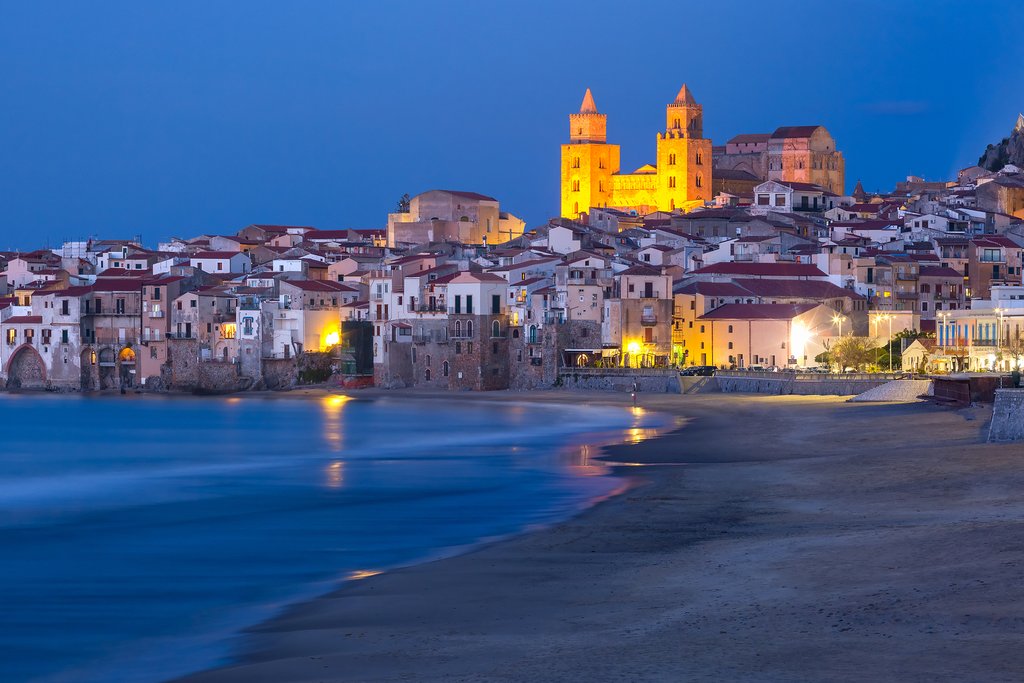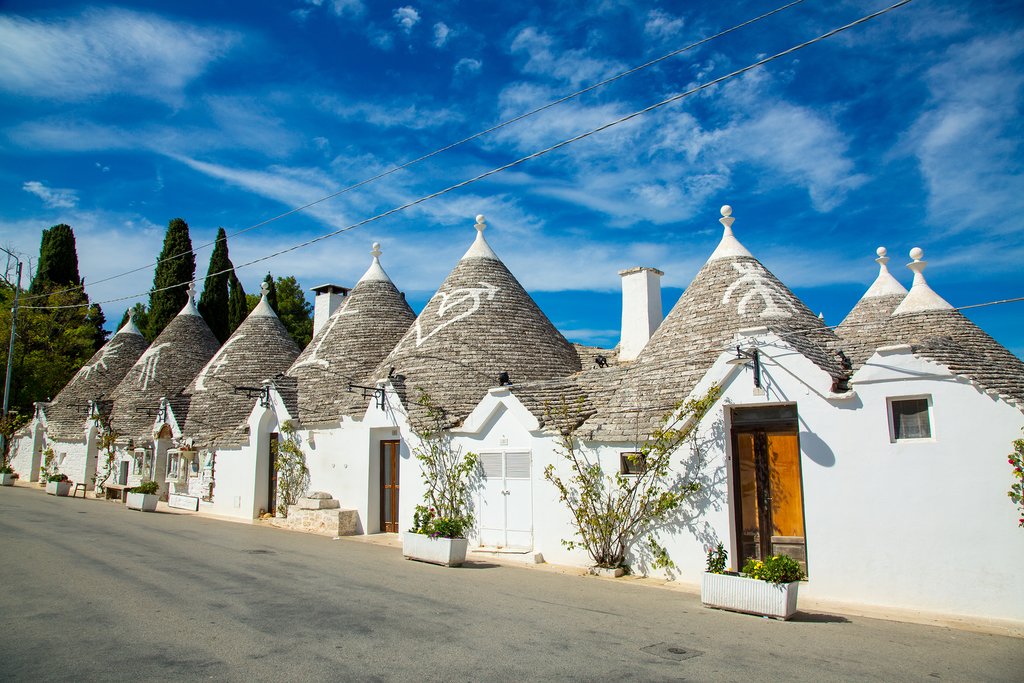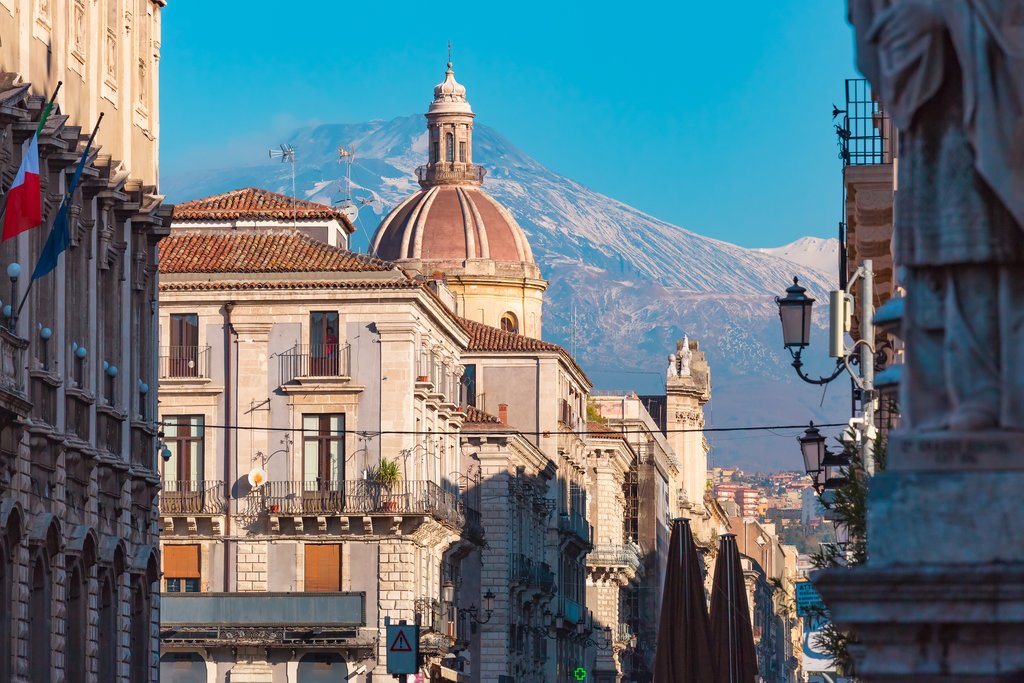
Puglia & Sicily Highlights - 11 Days

Highlights
- See storybook trulli homes in Alberobello
- Visit 9,000-year-old cave dwellings in Matera
- Tour the historic plazas and Baroque fountains of Palermo
- Dine on fresh seafood in sophisticated Taormina
- Roam ancient Greek ruins in Segesta
Brief Itinerary
| Day | Highlights | Overnight |
|---|---|---|
| Day 1 | Arrival in Puglia - Transfer to Alberobello | Alberobello |
| Day 2 | Alberobello Tour - Rione Monti & Aia Piccola | Alberobello |
| Day 3 | Day Trip to Matera | Alberobello |
| Day 4 | Alberobello to Lecce - Afternoon Cooking Class | Lecce |
| Day 5 | Lecce City Tour | Lecce |
| Day 6 | Flight from Bari to Palermo - Pick up Rental Car | Palermo |
| Day 7 | Palermo Street Food Tour | Palermo |
| Day 8 | Day Trip to Segesta & Erice | Palermo |
| Day 9 | Drive From Palermo to Taormina - Visit Cefalù | Taormina |
| Day 10 | Explore Taormina - Guided Mount Etna Hike | Taormina |
| Day 11 | Drive from Taormina to Catania - Departure |
Detailed Itinerary
Day 1: Arrival in Puglia - Transfer to Alberobello

Welcome to Italy's southern Puglia region—the heel of the boot! From the airport at the capital of Bari, you'll transfer about an hour southeast to Puglia's fertile green countryside and the town of Alberobello. Upon arrival in the town center, you'll check into your hotel.
Alberobello is a unique and charming place, which you'll discover on a self-guided tour. This UNESCO World Heritage Site is most famous for its trulli, circular 14th-century limestone buildings with conical roofs. These whitewashed storybook structures are used for everything from shops and restaurants to tourist lodgings and private homes. Other notable sites in town include the 17th-century Basilica, the trullo Church of St. Anthony, and the heritage museum Trullo Sovrano.
Alberobello also hosts many festivals during the summer, from an international folk festival to jazz, theater, and children's events. There are even religious festivals with music and fireworks, most of which are free. In the summer, the city's culture of passeggiata—long, leisurely evening strolls—continues well past midnight as pedestrians enjoy the warm summer nights.
Day 2: Alberobello Tour - Rione Monti & Aia Piccola

Today you'll have a guided tour of Alberobello. The UNESCO World Heritage trulli district in Alberobello is one of Puglia's most popular attractions, and the rest of the town is also lovely. Begin the tour on the road from Aia to the Trulli district, which stretches over seven hills.
The center of the city looks like most Italian small towns, with a few trulli located here and there. Head to the Rione Monti district to see many of these pointy white buildings clustered together. The neighborhood is situated on several narrow lanes on a hillside and is full of little gift shops selling souvenirs and Trulli-themed gifts. You'll have time to wander the picture-perfect streets to find everything from colorful terracotta whistles (a favorite local gift) to trulli-shaped knickknacks.
Exploring the hidden nooks of this neighborhood is a tour highlight, as many of the buildings contain tiny bars and the panoramic views from the terraces are stunning. Once you've explored to your heart's content, head up the Via Monte Michele to the Chiesa di Sant'Antonio, Alberobello's 20th-century Trullo church.
Continue to Alberobello's second trulli district—the quiet residential Aia Piccola, which is less frequented by tourists. The rest of the city is mostly composed of typical Italian buildings, with the occasional trulli popping up here and there. Conclude your tour with a visit to 18th-century Trullo Sovrano, the largest trullo home. This two-story building houses an excellent history museum and is outfitted with period fittings illustrating Italian life in the 1700s.
Day 3: Day Trip to Matera

In the morning, you'll transfer an hour west to the ancient hilltop city of Matera, where you'll enjoy a three-hour walking tour. The town is famous for the Sassi di Matera, well-preserved cave homes cut into the soft rock. These unique dwellings are considered to be some of Italy's first human settlements and are a designated UNESCO World Heritage Site.
The Sassi are located on both sides of the valley. The Sasso Caveoso on the south side are the most historically fascinating, while the Sasso Barisano are commercially developed and house offices and residences. The city of Matera also has many beautiful winding stairways, as well as incredible churches carved into the side of the volcanic rock.
You'll tour the city as well as the unique cave dwellings and rock churches as you learn about the city's history from your guide. See the cathedral of Sasso Barisano, as well as some of the filming locations for Mel Gibson's film The Passion of the Christ.
Day 4: Alberobello to Lecce - Afternoon Cooking Class

After breakfast, hit the road for the 1.5-hour trip to Lecce, a historic city on the coast of the Ionian Sea. It's the central city of the Salentine Peninsula and is over 2,000 years old. Thanks to its Baroque architectural monuments commonly found in the city, Lecce is nicknamed the "Florence of the Baroque" or "Rome of the South."
Lecce has a distinctly Greek culture, stemming back to its foundation by the Messapii, a lapygian tribe said to have been from Crete. The city's main attractions include Piazza San Oronzo, the 17th-century Duomo (designed by G. Zimbalo), Porta Napoli (the original gate to the old town), the Obelisk (erected in the 19th century to honor Ferdinand I of the Two Sicilies), and the beautiful Paisiello Theatre.
The Baroque 17th-century Basilica Di Santa Croce (Holy Cross Church) and 15th-century Torre del Parco are popular sites in the city center, while the Orto Botanico di Lecce (University of Lecce botanical garden) is a peaceful nature sanctuary featuring hundreds of fruit trees and other plants.
Chat with a local specialist who can help organize your trip.
Day 5: Lecce City Tour

Puglia's beaches are renowned for their rock formations and turquoise sea. Gallipoli Beach is one of the area's most popular, and Santa Cesarea Terme is a great place to explore small rocky pools. Spiaggia di Alimini is a 35-minute drive to the southeast of the city and is considered the area's finest beach for its white sand dunes and diverse ecology.
Day 6: Flight from Bari to Palermo - Pick up Rental Car

It's time to say goodbye to Puglia! At the appropriate hour, private transport will take you to the Bari airport for your flight to Palermo, which lasts a little over an hour. Sicily's regional capital boasts beautiful Mediterranean weather and a long and storied history with Roman, Byzantine, Arab, and Norman influences. You'll see this mix of cultures reflected in Palermo's architecture, music, and cuisine.
Upon arrival at the airport, you'll pick up your rental car and drive 45 minutes to your hotel in the heart of the city to settle in. The rest of the day is yours to spend as you like.
You can discover Palermo right away on a self-guided walking tour. The best place to begin is Palermo's historic center. Its medieval streets are easy to navigate by foot, and there are many attractions and restaurants within walking distance. To get your bearings, take a passeggiata (stroll) along the narrow Via Maqueda, a pedestrianized thoroughfare that connects the north of the city to the south. A good place to start is the Fontana Pretoria, a Baroque fountain in the Piazza Pretoria.
Day 7: Palermo Street Food Tour

One great way to experience Palermo is on a street food tour. You'll snack your way through the city's historic streets while visiting back-alley markets, modest bakeries, old bars, and various food stalls while on the hunt for sweet and savory eats.
You'll meet your guide in the morning and meander over to the Vucciria and Capo markets. These two open-air markets are so abuzz with activity that they're reminiscent of Arab souks. You'll discover how Sicily’s unique culinary history informs its street food scene as vendors of local produce and seafood proffer their goods.
Throughout, you'll visit bakeries, cafés, and food stalls to try a variety of popular Sicilian street snacks: pani câ meusa (sesame-flavored bread stuffed with fried veal and spleen), panelle (chickpea fritters) and arancini (deep-fried balls of rice stuffed with meat, vegetables, and cheese). Wash it all down with sweet Sicilian wine before digging into a seasonal dessert like cannoli (deep-fried pastries filled with sweetened ricotta cheese), gelato, or a refreshing granita (a fruity semi-frozen treat).
Day 8: Day Trip to Segesta & Erice

Depart from Palermo in the morning for a full-day excursion to Segesta and Erice. Start in Segesta, an archaeological complex located an hour away from Palermo.
The first thing you'll notice when you arrive in Segesta is the 2400-year-old Greek temple, which stands alone on its pedestal hill. Nearby you can see the medieval ruins and the ancient Agora, but the next highlight is further up on the hill—the theater, which dates to the 3rd century BCE. Behind the stage, you'll find an incredible panorama of hills and the Tyrrhenian Sea.
Afterward, transfer to Erice, a medieval city famous for its narrow winding streets, medieval arches, and decorated courtyards. Enter the old city by the Porta Trapani, then walk to the historic city center to reach the 14th-century Duomo, which houses marble sculptures, and the next-door bell tower. Climb the 110 steps to the top for a view of the city.
From here, follow the old city walls for a panoramic viewpoint, then explore the city's Spanish neighborhood, as well as the Church of San Giovanni Battista, Castello di Venere, and the 19th-century Torretta Pepoli. The Castello is a 12th-century Norman defensive fortress which houses ruins of a Roman spa and a temple.
Make your way back to the city gate, pausing at the Piazza Umberto I to see the ornate palazzi and Museo Antonio Cordici, which displays traditional crafts and trades.
Day 9: Drive From Palermo to Taormina - Visit Cefalù

Start early and drive one hour to Cefalù, a historic port town. You can begin a self-guided tour in the city center at the Lavatoio Medievale, a 16th-century washhouse that utilizes running water from the River Cefalino in its stone basins. Nearby is the Porta Pescara, a gate to Cefalù Beach that features great views of the coastline. Perhaps take a walk to the old harbor and stroll the seaside promenade; the city's Lungomare Beach is also a popular destination for visitors and locals.
You should definitely visit the 17th-century Bastione di Capo Marchiafava, one of many old defensive fortresses located along the coast. The view from the top of the Bastione is a real treat. Right nearby is the Norman-Arabic Duomo Basilica Cattedrale (Cefalù Cathedral) which dates to the 12th century. And if there's time, climb the Rocca, the promontory above the city. A steep staircase winds through city walls before emerging onto a rocky outcrop with stunning views of the city and ocean.
Continue your drive about three hours east to the seaside town of Taormina, where you'll check into your hotel.
Day 10: Explore Taormina - Guided Mount Etna Hike

Enjoy a leisurely morning on a self-guided tour of the city. Perhaps walk across the spit of land to Isola Bella and visit the 17th-century palace, elegant gardens, and fishing village. Alternatively, there are ruins of a medieval castle and the hilly streets of Castelmola, a small village located three miles (five km) north of Taormina. If you're in want of a beach day, there's the Taormina Mare, an impressive stretch of coastline characterized by rocky outcroppings, lidos (public beaches with amenities), and a variety of restaurants and cafés.
In the afternoon, head inland toward Europe's largest active volcano, Mount Etna. You'll arrive at Rifugio Sapienza, Etna's southern access point, and prepare for a guided hike. After organizing your equipment, you'll ride a cable car up 9,500 feet (2,900 m) to Torre del Filosofo, the last accessible lookout point before the summit. Enjoy the breathtaking scenery that includes solidified lava flows, smoke fumaroles, and wide vistas that stretch out to the Mediterranean.
Upon your return to your car, you'll make your way back to Taormina. Cap off the day with a rewarding scoop of gelato as you take a passegiata along the seafront promenade to enjoy the old gardens of the Villa Comunale.
Day 11: Drive from Taormina to Catania - Departure

After breakfast, make the hour drive south to Catania. Sicily's second-largest city next to Palermo, Catania sits at the foot of Mount Etna and deserves a little exploration if there's time before catching your departure flight. Depending on traffic, it typically takes 15 to 20 minutes to travel from Catania's center to the airport. Best to arrive at the airport at least two hours prior to your international departure (and with some extra time to drop off your rental car).
